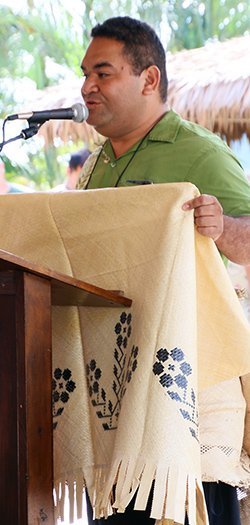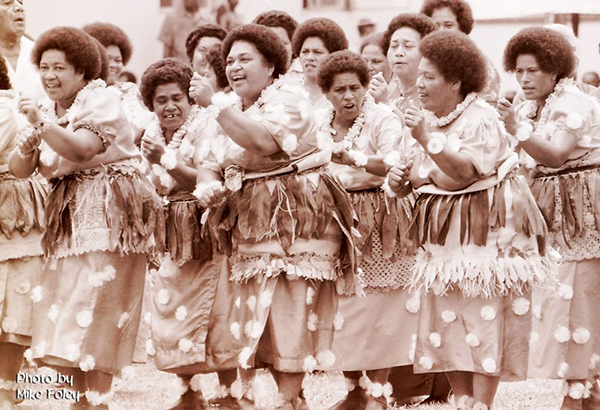 When one of the Polynesian Cultural Center’s most senior managers recently retired after 45 years of service, Alamoti “Moti” Taumoepeau — “chief” of the PCC’s Tongan Village — gave him a traditional laufala mat hand-woven from strips of dried pandanus leaves, and told him he should wear it as a ta‘ovala.
When one of the Polynesian Cultural Center’s most senior managers recently retired after 45 years of service, Alamoti “Moti” Taumoepeau — “chief” of the PCC’s Tongan Village — gave him a traditional laufala mat hand-woven from strips of dried pandanus leaves, and told him he should wear it as a ta‘ovala.
According to one long-ago story, a group of Tongans who came to visit the tu‘i Tonga or king arrived from a rough boat ride, and because they felt their clothing was not presentable, they cut the laufala mat which formed their boat’s sail and wrapped pieces of it around their waists. It is said the king was so pleased his subjects sacrificed their valuable sail that he ordered his court to dress that way from then on.
A more modern Tongan monarch, the late Queen Salote Tupou III (who reigned from 1918-1965, and is the grandmother of the current King Tupou VI) ordered that ta‘ovala become an official part of civil servant uniforms.
(Right: Taumoepeau presents a ta‘ovala mat as a gift.)
“To many people this just may be a mat, but to us Tongans the wearing of the ta‘ovala means so much more,” Taumoepeau explained. “It is the symbol of love and respect, subjugation to another’s will [e.g. a chief or king], and an obligation to fōnua, to the land and to its people.”
Today, practically every Tongan wearing traditional clothing includes a ta‘ovala mat or variation of one as part of the outfit. As in ancient times, this often still consists of a laufala mat wrapped around the waist and secured with kafa — sennit cord made from braided coconut husk fibers. Ta’ovala end above the knees, but they can hang down to the ankles, and on some occasions even be drawn over the head.
The more stylish kiekie: Tongan women — and some men — often wear a kiekie, a variation of the ta‘ovala. A kiekie is an ornamental string-like girdle also wrapped around the waist and usually ending above the knees, but they are typically crafted so the tupenu (the lavalava or wrap-around underneath) can be seen through the gaps. Kiekie are made in a wide variety of designs with natural and/or introduced materials, including shells, embroidery and ngatu (tapa or bark cloth) strands. The Tongan sisi is a similar ornamental girdle, but it’s usually made from leaves, flowers and even fruit.
 |
| This 1982 PCC picture taken in Fiji shows Lau archipelago women dancing while wearing both ta‘ovala and sisi. The Lau Islands are located between Tonga and Fiji. The people there are considered Fijians, but they share a great deal of Tongan blood and culture. |
In addition to the more stylish and colorful nature of kiekie, some Tongans might prefer them because the larger, mat-type ta‘ovala can feel bulky and quite warm. Indeed, for some traditional ceremonial occasions, they can be so heavy that attendants have to assist the ones wearing them to walk, sit and stand.
The choice of type also changes with the occasion. Ta‘ovala worn to a funeral, for example, might be older, torn, or perhaps not particularly clean, as marks of sadness. In another classic example from years ago, a former “chief” of the PCC’s Tongan Village was once asked to wear his finest traditional clothing for a promotional photography session. When the art director asked about the holes and general condition of his ta‘ovala, he replied, “I thought you wanted me to wear my best. This mat has been in my family for over 100 years.”
Getting back to Taumoepeau’s presentation to our retiring manager, he said, “I don’t want you to put this on the floor and hang it on the wall. This is for you to wear whenever you can, that it may be an additional reminder to you of an outward expression of an inner commitment . . . to your family and friends.”
So, the next time you’re at the Polynesian Cultural Center — or any place where Tongans in traditional clothing gather, pay a little extra attention to the respect they’re showing with their ta‘ovala.
Story and images by Mike Foley
 |
Mike Foley, who has worked off-and-on
at the Polynesian Cultural Center since 1968, has been a full-time freelance writer and digital media specialist since 2002, and had a long career in marketing communications and PR before that. He learned to speak fluent Samoan as a Mormon missionary before moving to Laie in 1967 — still does, and he has traveled extensively over the years throughout Polynesia and other Pacific islands. Foley is mostly retired now, but continues to contribute to various PCC and other media.
|

Recent Comments